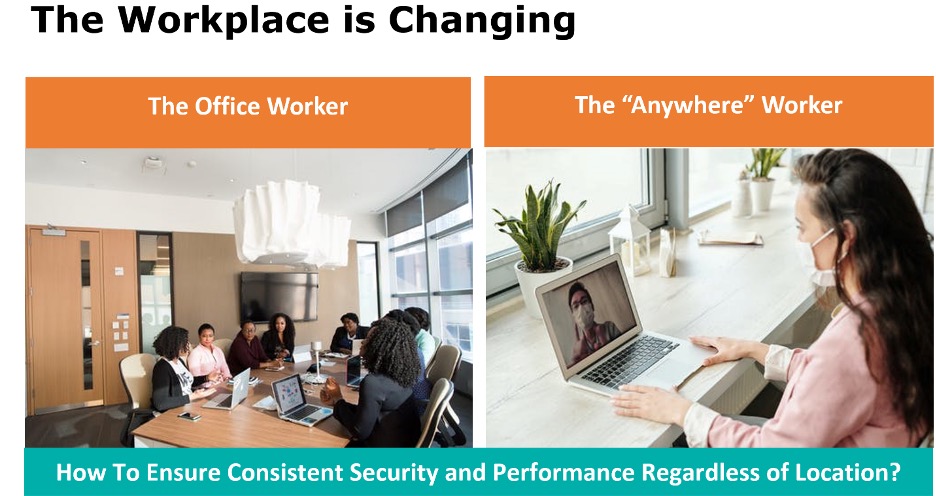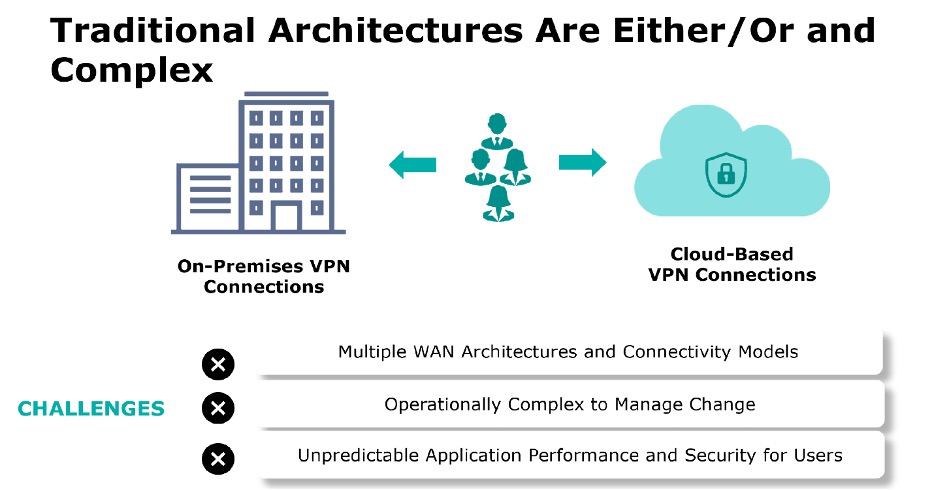Enabling a Hybrid Workplace for the “Anywhere” worker

The Brave New Workplace
The workplace is fast evolving. The onset of Covid-19 rapidly accelerated the evolution of the workplace for enterprises in a manner that, in normal times, would almost be construed as disruptive.
Enterprise CIOs have adapted remarkably in getting large swaths of the employee workforce into remote working environments, while the traditional office spaces are largely empty. Employees have also adapted to working from their home environments, and others have moved outside of their home base to be closer to their families or work from cities that are less expensive. Now they are literally accessing corporate applications from anywhere & everywhere.
For CIOs this has given birth to the concept of the “Anywhere” worker.

The mandate for most CIOs, as they look at long term architectural underpinnings, is to have these “Anywhre” workers be treated as first-class citizens in terms access to corporate applications, and to ensure they have secure connectivity and highly predictable application performance in much the same way as a worker in the traditional office.
The Renewed Focus on Productivity
Previously, home working and teleworking was allowed with the focus on flexibility. This thinking was okay when it was a smaller portion of workers working remote (less than 20% of the workforce). However, with large swaths of the population now working remote, CIOs have to consider the impact on productivity as well. This has a direct co-relation to business efficiency.

While the shift back to traditional office environments will come about, CIOs are really focused on a model that allows them to have a workforce that is highly productive regardless of whether they are in an on-premises office environment or working remotely. The location should NOT matter for productivity and consistent access to corporate applications.
Traditional Architectures Are Complicated
While remote access solutions have been around for ages, the traditional architectures are challenged to deliver against the new model. And while clients have been able to connect to on-premises aggregators or cloud-based ones, many organizations have had to set up parallel WAN infrastructures for remote access and private networking. The operational complexity of managing them in a consistent manner have also been challenging, and it has always been a complex undertaking to provide predictable application access in a secure manner to remote workers.
These were acknowledged problems, but since they affected a smaller portion of the workforce, CIOs and IT organizations managed them on a best effort basis and in many cases, threw more bandwidth at the problem and subsidized internet connectivity for employees working remote.

To be able to offer a flexible architecture that accommodates the notion of users and applications being anywhere, with a consistent security posture, and delivered as-a-service, is something in line with what many CIOs are actively exploring. Either/or architectures are good to get things going quickly but become operationally complex to sustain in the long run.
The Aryaka Approach for Hybrid Workplaces
This is where the Aryaka solution makes a difference. Built on the principles of the Cloud-First WAN, it offers the right elements of the network as-a-service for managed SD-WAN as well as Secure Access Service Edge (SASE) architectural requirements.
- First off, it is fully managed. CIOs and their organizations can consider it their “Easy button.” It is very simple to do adds, moves and changes. The architectural flexibility with Aryaka’s Cloud First WANs allows organizations to blur the boundaries between sites and users, on-premises and cloud deployments as well as network and network security, all delivered as-a-service.
- Next, the clients themselves terminate on the PoPs and leverage the service intelligence in the Aryaka global points of presence, giving them the ability to connect from “anywhere,”, but also able to leverage the built-in WAN optimization in the PoPs that provide highly predictable application performance
- Finally, the convergence of network and network security delivered as-as-service really drives simplification and lowers the total cost of ownership.
The combination of all the above make it easier for network and security teams to help drive the adoption of hybrid workplaces with minimal disruption to their business workflow, while maximizing productivity for “Anywhere” workers and partners.

We are seeing tremendous traction with the integration of Check Point software as well as Palo Alto firewalls on our service edge notes – the ANAPs – as virtualized functions that are both hosted and managed. These are already driving consolidation of the network and security functions at the edge and helping lower TCO. The Aryaka Service PoPs serve as control points in all these instances with the rich service intelligence constructs built into them.
These now get extended with the private access offering. The Aryaka SmartSecure offering and the principles of the Cloud-First WAN are purpose built to address the needs of SD-WAN and SASE architectures, at scale, in a consistent manner globally!
Building Blocks for the Next-Gen Managed SD-WAN and Secure Access Service Edge (SASE)
At a fundamental level, SASE, as defined by Gartner, is defining the convergence of network-as-a-service with network security-as-a-service. It is a Cloud-First architecture focusing on service delivery model that embraces both site centric and user-centric requirements.
The Aryaka Cloud-First WAN is a powerful way for enterprises to future proof their network and security architectures for the next generation of SD-WAN and SASE architectural build outs. CIOs, Network and Security professionals, as well as Cloud architects can take confidence in this being an excellent choice for their organization if they are interested in taking advantage of a fully managed, integrated offering.

Eventually, the goal of such architectures is to provide the maximum flexibility for organizations to allow their businesses to manage change better, with minimal disruption and with a high degree of agility. CIOs are change agents today, mandated with transformation initiatives that propel their organizations faster with reduced risk. WAN transformation and security in that context are vital underpinnings to get right in that context.
All these solutions are a means to an end meant to make employees more productive, collaborative and to help drive greater engagement and adoption of a company’s offerings with its partners and customers.

Employees make an organization and today this organization is evolving. As more organizations get attuned to the idea of thinking about work as not a place, but rather an activity, it will have a more profound impact on the architectures that really are geared to drive this change.
The new offering from Aryaka allows such organizations to take a confident step in that direction.
Press Release: Aryaka Announces the Industry’s Most Flexible VPN for Hybrid Workplaces and the “Anywhere” worker.
Webinar: Re-Defining VPN Services in the Cloud-First Era: Click here to register: https://www.aryaka.com/events-webinars/re-defining-vpn-with-sase-sd-wan/




